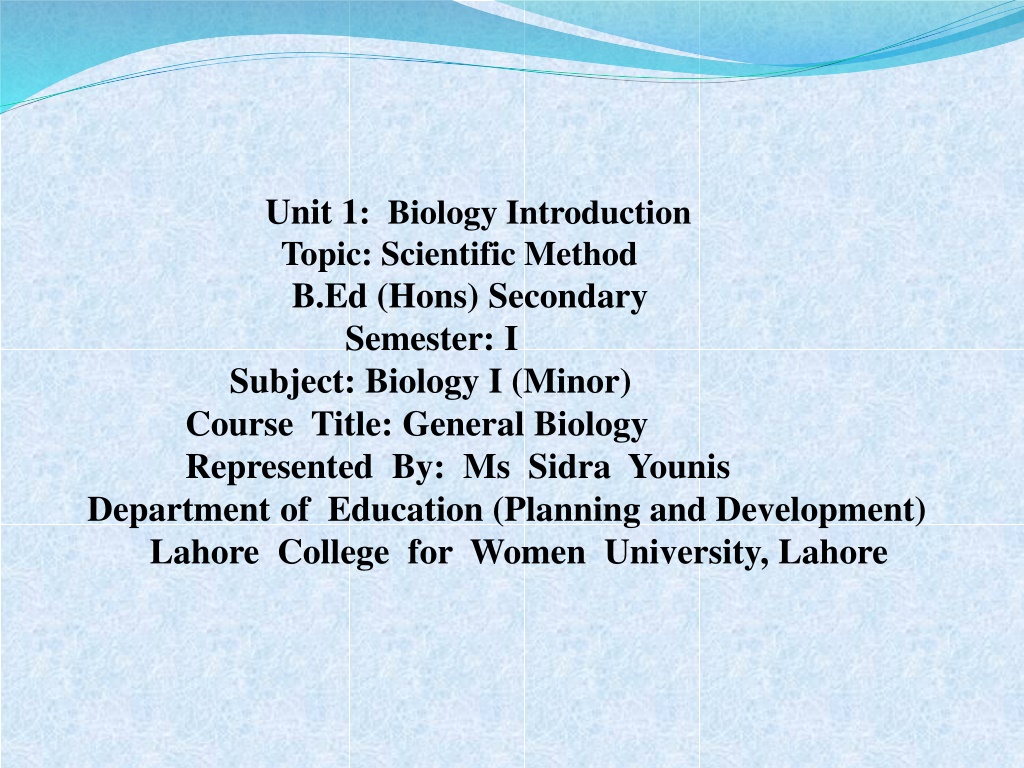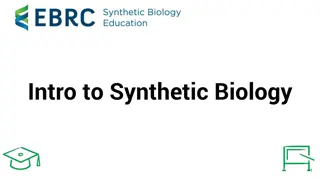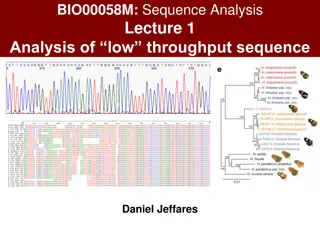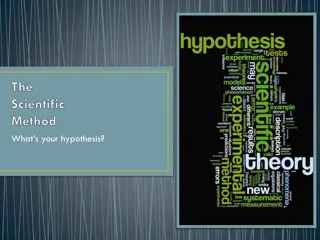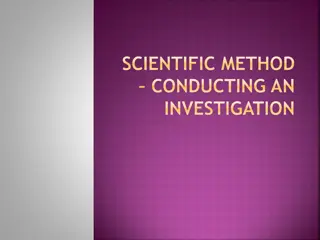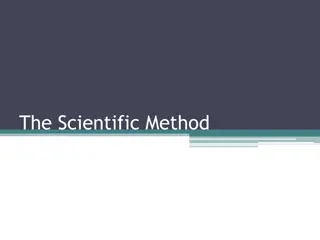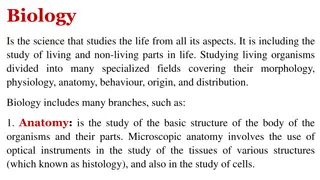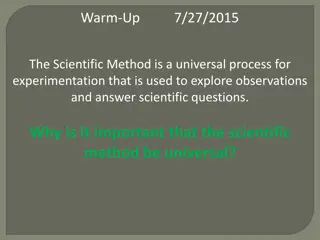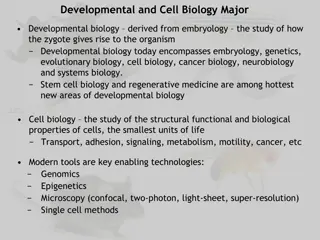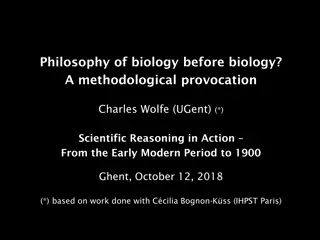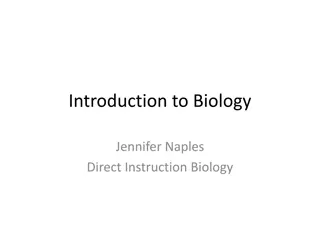The Scientific Method in Biology
The scientific method is a systematic approach used in biology to investigate and solve problems. It involves observations, forming questions, creating testable hypotheses, conducting experiments, analyzing data, drawing conclusions, and publishing results. Through this method, researchers can gather and evaluate evidence to support their theories and advance our understanding of the natural world.
Download Presentation

Please find below an Image/Link to download the presentation.
The content on the website is provided AS IS for your information and personal use only. It may not be sold, licensed, or shared on other websites without obtaining consent from the author.If you encounter any issues during the download, it is possible that the publisher has removed the file from their server.
You are allowed to download the files provided on this website for personal or commercial use, subject to the condition that they are used lawfully. All files are the property of their respective owners.
The content on the website is provided AS IS for your information and personal use only. It may not be sold, licensed, or shared on other websites without obtaining consent from the author.
E N D
Presentation Transcript
Unit 1: Biology Introduction Topic: Scientific Method B.Ed (Hons) Secondary Semester: I Subject: Biology I (Minor) Course Title: General Biology Represented By: Ms Sidra Younis Department of Education (Planning and Development) Lahore College for Women University, Lahore
Scientific Method Definition Scientific method was first recorded in 1850 -1855. Scientific method is a method of a research in which a problem is identified, related data are collected and the hypothesis is observational tested. Steps of Scientific Method 1. Observations 2. Question 3. Hypothesis 4. Experiment 5. Data analysis 6. Conclusions
1: Observation As the first step in solving the problem the people recalls the pervious observation or makes the new one. An observation is the process of observing something or someone. Any data can be noted during experiment can be called as observation. Observation can be of two types Qualitative observation: Qualitative observation is an observation in which we observe the quality of an object. Quantitative observation: Quantitative observation is an observation in which we observe the quantity of an object. 2: Question Once you ve made observation, you must formulate a question about what you have observed. A scientific question is a question that may lead towards hypothesis and help us in answering the reason of a question. There are some certain characteristics It should be testable. It should have answers.
3: Hypothesis In scientific method a hypothesis, is a testable statement about the relationship between two or more variables explanation for some observed phenomenon. The basic idea of hypothesis is that there is no fixed outcome. Hypothesis can have following characteristics It should be a tentative idea. It should be kept as simple as possible. It should be testable. 4: Experiment After hypothesis, experimentation is the most basic step of the scientific method. A person performs experiments to see if hypothesis are true or not. Through experiments, a person learns which hypothesis is correct. The incorrect hypothesis is rejected and the correct one is accepted.
5: Data analysis After performing an experiment and collecting data, the person uses it to draw a conclusion about the strength of the hypothesis. If the data proves the hypothesis correct, the question is answered. But if the data disproves the hypothesis, the person should research again to form a hypothesis and experiment to test it. 6: Conclusion The final step of the scientific method is conclusion. Publishing of results is an important part of scientific method. This is the step in which all the results from the experiment are analyzed.
Example: Malaria Malaria is derived from two words Mala means bad and Aria means air . Malaria is a serious fatal disease that infects a mosquito which feeds on humans. People who are suffering from malaria are very sick. Its symptoms are high fever, shaking- chills and flu like illness. 1: Observation In nineteenth century, many different causes of malaria were suggested. There were some major observations about malaria. Malaria and marshy areas have some relation. Drinking the water of marshes does not cause malaria. Plasmodium is seen in the blood of malarial patients. 2: Question Can plasmodium cause malaria?
3; Hypothesis Scientist uses whatever information they can get at that time and with the help of observation they made one or more hypothesis and hypothesis was Plasmodium is the cause of malaria 4: Deduction Scientist does not know whether his hypothesis is correct or not. One of the deductions from the above hypothesis was; If plasmodium is the cause of malaria, then all persons ill with malaria should have Plasmodium in their blood 5: Experiment In the next step, the scientists perform experiment to test the deduction which was designed as; Scientist examined the blood of 100 malarial patients and 100 healthy persons under the microscope.
6: Data analysis The results of the experiments showed that all malarial patients had plasmodium in their blood while seven out of hundred healthy people also had plasmodium in their body that is the incubation period, incubation period is a period between the entry of parasite in host and the appearance of the symptoms. 7: Conclusion The quite convincing result proved the hypothesis was true Plasmodium is the cause of malaria.
Life Cycle of Malaria The natural history of malaria involves cyclical infection of humans and female Anopheles mosquitoes. In humans, the parasites grow and multiply first in the liver cells and then in the red cells of the blood. In the blood, successive broods of parasites grow inside the red cells and destroy them, releasing daughter parasites ( merozoites ) that continue the cycle by invading other red cells. The blood stage parasites are those that cause the symptoms of malaria. When certain forms of blood stage parasites (gametocytes, which occur in male and female forms) are ingested during blood feeding by a female Anopheles mosquito, they mate in the gut of the mosquito and begin a cycle of growth and multiplication in the mosquito. After 10-18 days, a form of the parasite called a sporozoite migrates to the mosquito s salivary glands.
Cont. When the Anopheles mosquito takes a blood meal on another human, anticoagulant saliva is injected together with the sporozoites, which migrate to the liver, thereby beginning a new cycle. Thus the infected mosquito carries the disease from one human to another (acting as a vector ), while infected humans transmit the parasite to the mosquito, In contrast to the human host, the mosquito vector does not suffer from the presence of the parasites.
Steps of Malarial Cycle: Malaria infection begins when an infected female Anopheles mosquito bites a person injecting Plasmodium parasites, in the form of sporozoites, into the bloodstream. The sporozoites pass quickly into the human liver. The sporozoites multiply asexually in the liver cells over the next 7 to 10 days, causing no symptoms. In an animal model, the parasites, in the form of merozoites, are released from the liver cells in vesicles, journey through the heart, and arrive in the lungs, where they settle within lung capillaries. The vesicles eventually disintegrate, freeing the merozoites to enter the blood phase of their development. In the bloodstream, the merozoites invade red blood cells (erythrocytes) and multiply again until the cells burst. Then they invade more erythrocytes. This cycle is repeated, causing fever each time parasites break free and invade blood cells. 1. 2. 3. 4. 5.
Cont 6. Some of the infected blood cells leave the cycle of asexual multiplication. Instead of replicating, the merozoites in these cells develop into sexual forms of the parasite, called gametocytes, that circulate in the blood stream. 7. When a mosquito bites an infected human, it ingests the gametocytes, which develop further into mature sex cells called gametes. 8. The fertilized female gametes develop into actively moving ookinetes that burrow through the mosquito's midgut wall and form oocysts on the exterior surface. 9. Inside the oocyst, thousands of active sporozoites develop. The oocyst eventually bursts, releasing sporozoites into the body cavity that travel to the mosquito's salivary glands. 10. The cycle of human infection begins again when the mosquito bites another person.
